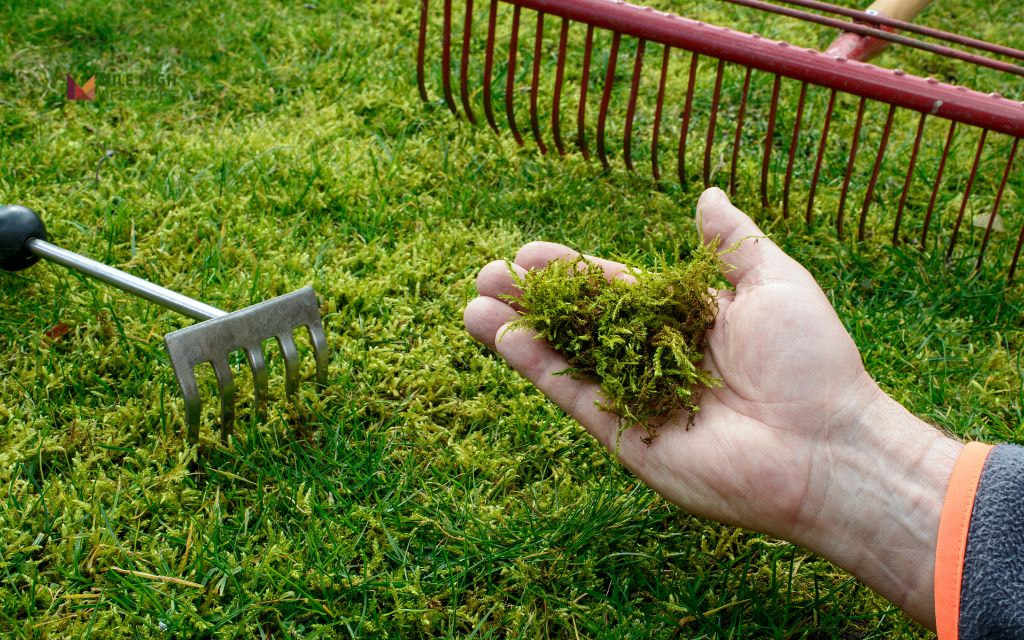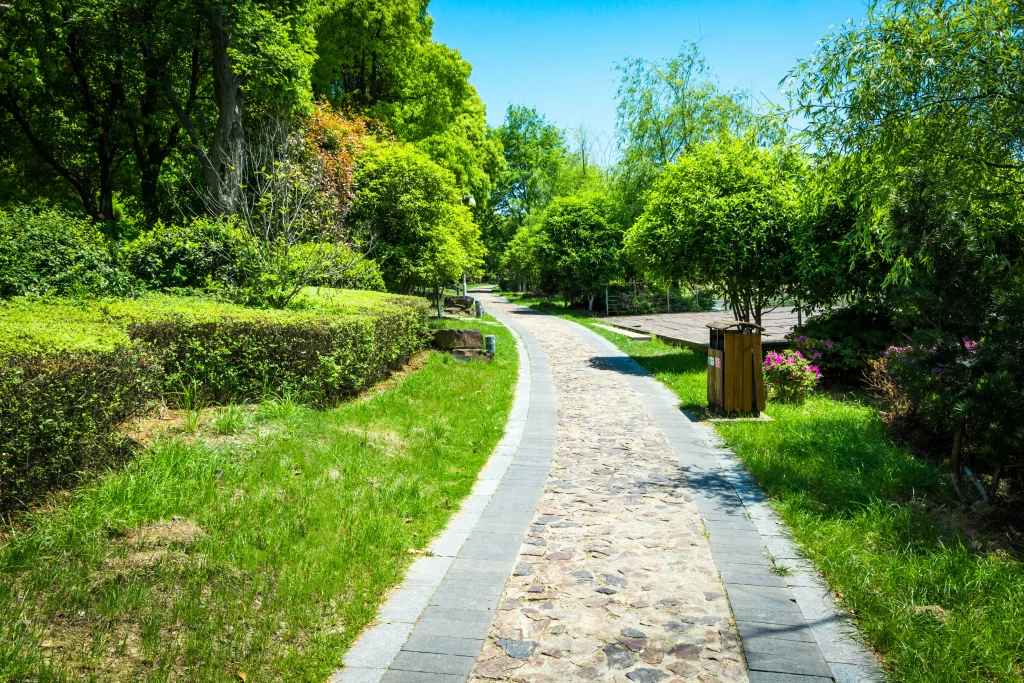Ideally, your final mowing of the season should take place roughly a week before the first frost, when soil temperatures consistently drop below 50°F and grass growth slows significantly – typically early to mid-November in Denver.
This timing protects your turf from winter stress and prevents damage to dormant grass. Continuing to mow after grass enters dormancy can damage crowns, compact soil, and increase disease risk. Learn more in this blog below!
Key Signs It’s Time to Stop Mowing Your Lawn
Lawn care isn’t governed by the calendar alone. Your grass responds to temperature and light changes that signal the end of the growing season.
The primary indicator to watch is soil temperature. When measurements consistently drop below 50°F, grass growth naturally slows as the plant redirects energy to root development. A soil thermometer helps track these changes precisely across your yard.
Growth rate provides another clear signal. When your lawn produces minimal clippings after 10-14 days between mowings, it’s entering dormancy. Kentucky bluegrass and other cool-season grasses common in Denver lawns will grow more slowly before stopping completely.
Late-season signals become increasingly evident as winter approaches. Morning frost that remains on grass blades, soil moisture that doesn’t evaporate by midday, and the feeling that mowing seems unnecessary all indicate your lawn is preparing for dormancy.
Your lawn tells you it’s done growing if:
- No visible growth occurs after 10+ days
- Clippings barely fill the mower bag
- Temperatures consistently stay below 50°F
- Lawn remains damp or frosty until late morning
- You’re primarily mowing fallen leaves, not grass
The Ideal Time to Stop Mowing in Denver (Month-by-Month Guide)
| Month | Mowing Frequency | Notes |
| September | Every 5-7 days | Cool-season surge – maintain regular mowing at 2.5″ |
| October | Every 10-14 days | Growth slows – gradually raise deck to 3-3.5″ |
| Early Nov | Final mow window | Stop when daytime temps stay below 50°F |
| Mid-Late Nov | No more mowing | Grass dormant; avoid mower traffic on frozen turf |
September remains an active growth period for Denver lawns. The combination of cooler temperatures and consistent moisture often triggers a growth surge in cool-season grasses. Maintain your regular mowing schedule at about 2.5 inches to keep your lawn healthy.
October marks the transition period. As temperatures fluctuate, gradually raise your mower blade height and extend the time between mowings. Monitor nighttime temperatures and weather forecasts to anticipate the upcoming dormancy period.
Most Denver lawns stop growing around early to mid-November when soil temperatures consistently drop below the critical 50°F threshold. This timing varies slightly based on your specific microclimate, elevation, and sun exposure.
During unusually warm fall seasons, some Denver lawns may continue growing into mid-November. Trust your observations of growth rate over the calendar date when determining when to stop mowing lawn in fall.

What Happens If You Mow Too Late in the Season?
Mowing after your grass enters dormancy causes physical damage to the turf, particularly to the crown of the plant where growth originates. Cold, brittle grass blades tear rather than cut cleanly, creating entry points for disease.
Operating a heavy mower over partially frozen soil leads to compaction and rutting that damages root systems. These compacted areas hold excess moisture and often become problem spots in spring.
Short grass heading into winter faces increased vulnerability to desiccation from dry winter winds and temperature fluctuations common along the Front Range. The reduced blade surface also diminishes the plant’s ability to photosynthesize during brief warm periods.

Any “last-minute” mowing during frost conditions significantly increases the risk of spreading fungal spores and diseases like snow mold across your lawn. The damaged tissue struggles to heal in cold conditions.
Late Mowing Risks:
- Compacts cold, moist soil and creates spring problem areas
- Increases snow mold and disease vulnerability
- Weakens turf recovery capacity for spring
- Tears rather than cuts grass blades, stressing the plant
Final Mow Tips Before You Stop for Winter
For your final mow of the season, choose a dry, sunny day when temperatures reach at least 45°F with no frost present. This timing ensures grass cuts cleanly and minimizes stress.
- Set your mower height between 2.5-3 inches—never lower. This height provides enough leaf surface for photosynthesis while preventing matting under snow. Taller grass also insulates crown tissue from temperature extremes.
- Sharpen mower blades before this last cut to ensure clean cuts that heal properly. Dull blades tear grass, leaving ragged edges that increase moisture loss and disease entry points.
- Collect clippings if they form thick mats that could smother the lawn. However, if clippings are minimal, mulching them provides additional nutrients for root development during dormancy.
- Remove fallen leaves during this final mowing session. Leaves left on the lawn create moisture-trapping areas that promote snow mold and other fungal diseases during winter.
Once temperatures drop below 45-50°F for several consecutive days, resist the urge to mow again, even if occasional warm days occur. The grass has entered its protective dormancy stage.
Do’s and Don’ts for the Last Mow:
- Do check soil moisture first—mow only when soil is firm but not frozen
- Do clean and properly store your mower afterward for winter
- Don’t mow through frost or snow
- Don’t cut lower than 2.5 inches
- Don’t delay until grass has already entered full dormancy
How to Prepare Your Lawn for Winter After the Final Cut
After completing your final mow, shift your lawn care focus from promoting growth to providing protection. The dormancy period requires different maintenance practices.
- Clear all debris, toys, and equipment from the lawn surface. Anything left on dormant grass creates dead spots through smothering and provides habitat for pests and diseases.
- Apply a slow-release fall fertilizer with higher phosphorus and potassium content in late October. This application supports root development during dormancy without forcing vulnerable top growth. This timing aligns with when grass stops growing in Colorado.
- Minimize foot traffic on frozen grass, especially repeated paths. Walking on frozen turf breaks grass blades and compacts soil, creating problems that persist into spring.
Winter Lawn Prep Checklist:
- Remove leaves and debris weekly until snowfall
- Apply appropriate slow-release fall fertilizer by late October
- Shut off and blow out your irrigation system before freezing temperatures
- Avoid walking or dragging objects over frosty grass

Myth vs Fact: Common Misconceptions About Late Mowing
- Myth: “You should mow as long as the grass looks green.” Fact: Grass remains green well into dormancy due to stored chlorophyll—color alone doesn’t indicate active growth. Check for actual blade elongation before deciding to mow.
- Myth: “Shorter is safer before snow.” Fact: Cutting too short increases crown exposure to winter temperature extremes and raises fungal disease risk. Maintain 2.5-3 inches for optimal winter protection.
- Myth: “Fall mowing isn’t as important as spring and summer maintenance.” Fact: Fall mowing practices directly impact spring green-up timing and overall turf health. The final cuts of the season significantly influence winter survival rates and spring recovery.
- Myth: “You can mow anytime as long as it’s not snowing.” Fact: Soil temperature and moisture conditions matter more than precipitation. Mowing frozen or frost-covered turf causes physical damage regardless of snowfall.
Conclusion
Stop mowing when grass stops growing – not just when the first snow falls. For most Denver lawns, this means completing your final mow in late October or early November when soil temperatures consistently drop below 50°F.
A properly timed final mow at the right height, combined with appropriate winter preparation, creates the foundation for rapid spring recovery. This approach minimizes winter damage and reduces maintenance challenges when growth resumes.
Mile High Lifescape offers professional end-of-season lawn assessments and winterization services for homeowners uncertain about their lawn’s specific needs. Our experts analyze soil conditions, grass type, and microclimate factors to determine the optimal timing for your final mow.
Unsure if it’s time for your final mow? Contact Mile High Lifescape at (303) 877-9091 for a professional evaluation and winter prep service.
Frequently Asked Questions (FAQs)
What temperature is too cold to mow the lawn?
Avoid mowing when temperatures drop below 45°F. The grass becomes brittle and prone to damage, and mower engines may struggle in cold conditions.
Can I mow after the first frost?
Only if the lawn fully dries out and shows actual growth. Wait until temperatures reach at least 45°F and frost completely melts before considering mowing frozen turf.
Is scalping before winter a good idea?
No – cutting lower than 2.5 inches exposes crown tissue to temperature extremes and increases winterkill risk. Maintain proper height for winter protection.
Should I mow one more time after snow melts in fall?
Only if grass actually regrows and temperatures warm consistently above 50°F – a rare occurrence in Denver’s climate after mid-November.
How can I tell if my lawn is dormant?
No blade elongation for 10+ days, soil temperatures remaining below 50°F, and frost that persists on grass blades until late morning all indicate dormancy has begun.
What month should I stop cutting my grass in Denver?
Most Denver lawns require their final mow between late October and early November, though specific timing varies based on elevation, exposure, and seasonal weather patterns.
Is it better to leave your lawn long or short for winter?
Maintain 2.5-3 inches height for winter – tall enough to protect crowns and root systems while short enough to prevent matting under snow, striking the optimal balance for cold-weather protection.
